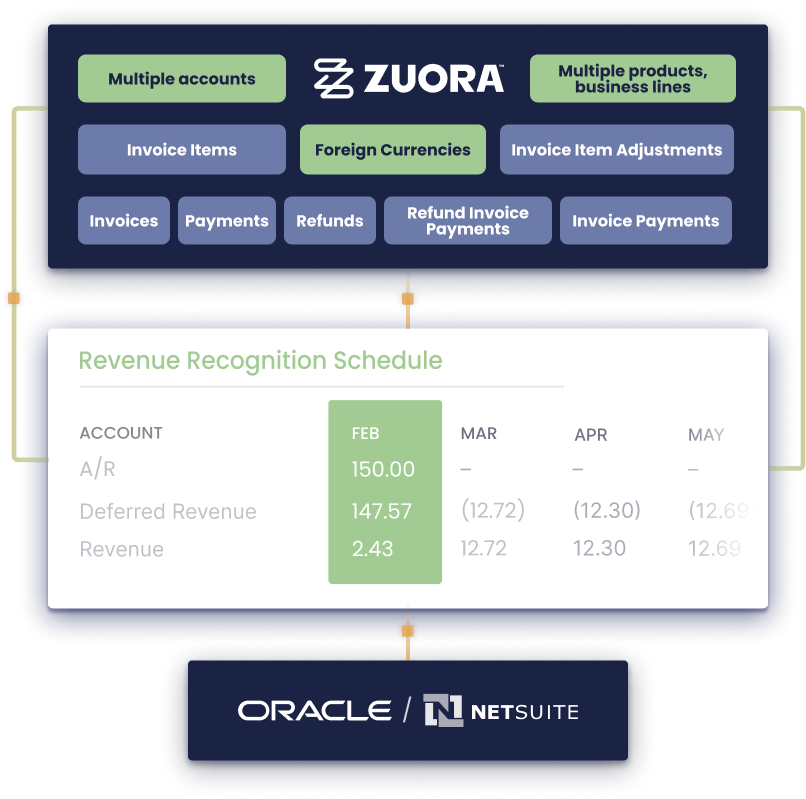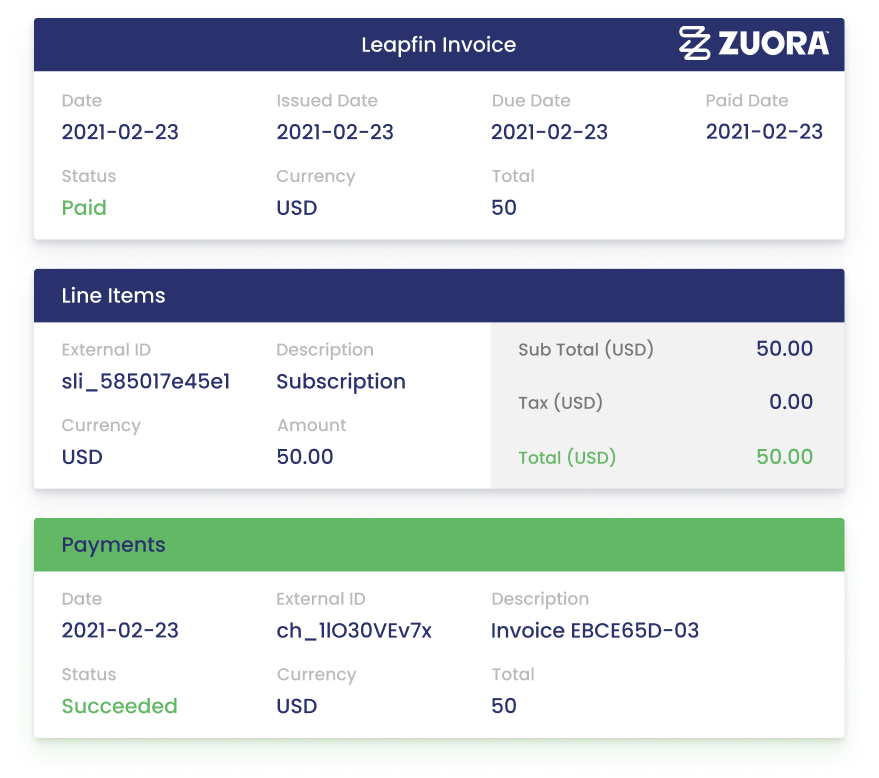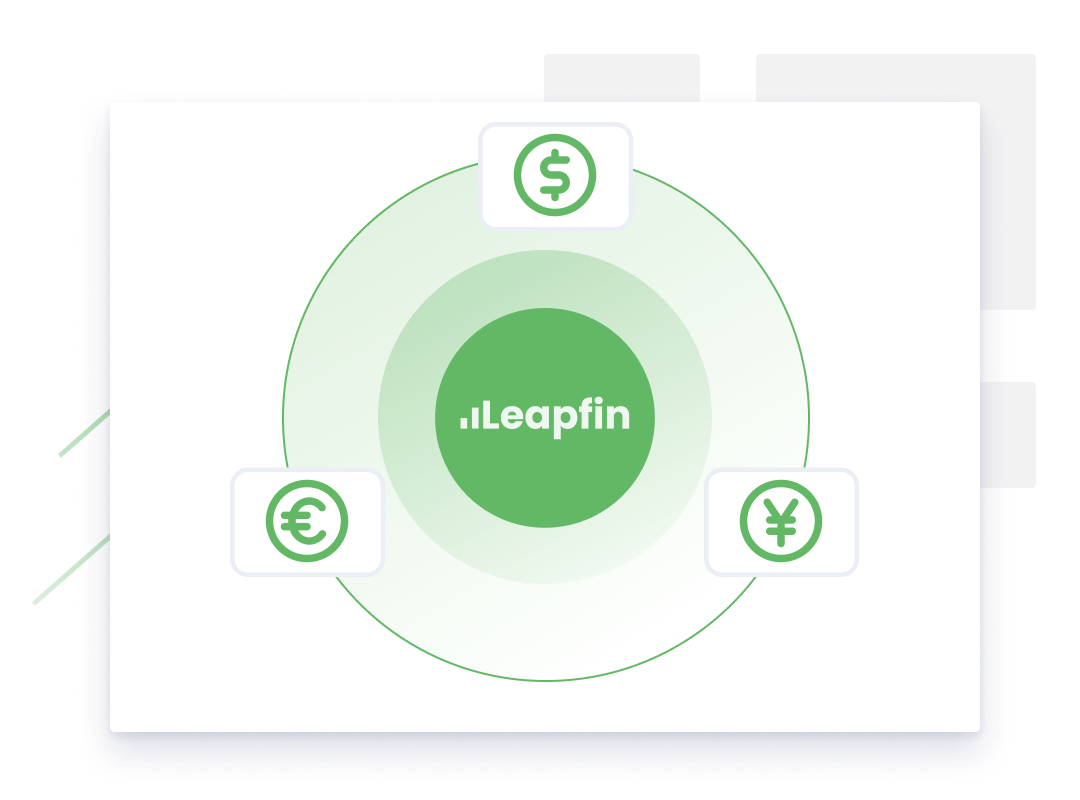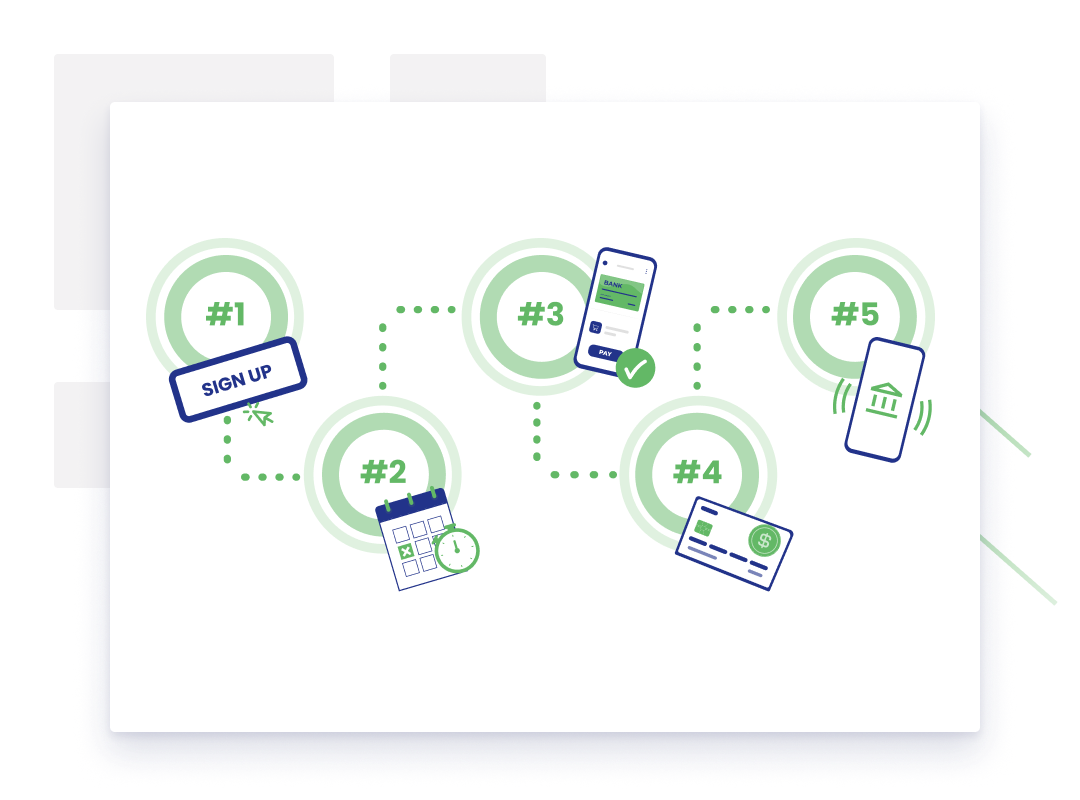Zuora NetSuite integration in Leapfin
View your subscription business transactions — like invoices, payments, and refunds — from Zuora in real-time alongside transactions from other PSPs and integrate them into Oracle NetSuite’s cloud ERP. Improve business processes and maximize profits with better data.

Here's how Leapfin makes your Zuora Netsuite integration easier
Accurate reporting and analysis with real-time transaction insights
Without accurate reporting, how will you know if you offer too many discounts or if your refund policy is too lenient? How do you know if your subscription billing approach maximizes revenue
Answer these questions with detailed transaction insights and segmentable reports. Combine subscription billing and payment insights from Zuora with data from other operational tools like Stripe, Apple App Store, and more to view your entire transaction lifecycle in one platform before integrating the aggregated subledger report into NetSuite.

Reconcile differences automatically
Dozens of subscription events flow through Zuora weekly, monthly, quarterly, and annually – from invoices to payments to refunds. You still have irreconcilable differences in your accounting and mistimed transaction reports. Since some parts of your transaction lifecycle live in other operational tools, events might get attributed to the wrong accounting period.
Mitigate these issues automatically by streamlining Zuora events with transaction activities in other systems, assigning each activity to the proper period, and then creates an auto-reconciled subledger that you can push into NetSuite. No Microsoft Excel workarounds or late nights required.

Pre-built logic for accurate financials
Apply pre-built logic to your Zuora transaction data to auto-generate specialized journal entries like subscription revenue recognition entries or deferred revenue reporting. Do a third cool thing with all that extra time.

Easy, pain-free audits with traceable transaction linking
Remember when audits meant reconstructing the transaction story from order to cash? What happens if you invoiced a user a few months ago and reinvoiced them a week ago because of a dispute?
Answer auditor questions in minutes, not days, with a full view into your transaction data, data changes, and linking between related activities and back to their source.

What you get with Leapfin, Zuora, and NetSuite
Access a single source of truth for all your transactions and financial data in Leapfin, an extensible Finance Data Platform that handles thousands of daily transactions, even during peak seasons.
Apply pre-built logic to transaction data to auto-calculate revenue and cost of revenue metrics.
See Zuora data processes in real-time and automatically detect data errors, such as missing fields and invalid values so that you can fix them upon data integration.
Sync and view Zuora invoices and payments alongside transaction activities in other operational tools in a unified Financial Record that links back to its source for easy reporting and audit.
View real-time transaction data across multiple business units, products, geographies, customer demographics, and segments updated daily, weekly, or monthly, and automatically upload Financial Records into NetSuite, no spreadsheets required. Use this data for your finance data dashboards, scenario analyses, and forecasts.
-
Leapfin is our valued partner for revenue recognition. All of the PSP data that we need for the month-end close lives in Leapfin and gets updated in real-time.Emily Eagon Controller @ Medium
Automate your journal entries at scale with Leapfin
FAQs about the Stripe Netsuite integration in Leapfin
Leapfin offers a native Zuora integration, fully configurable to the data you want to pull, whether it’s charges, refunds, disputes, payouts, or anything else. Leapfin integrates Zuora with NetSuite using a four-step process:
1. Leapfin synchronizes Recurly payments and charges with data in other operational systems, creating a unified Financial Record that tells the whole transaction story. Leapfin turns this data into automated journal entries.
2. Leapfin applies business logic, like tax rates, foreign exchange rates, or linear revenue recognition schedules to the entries.
3. Leapfin automatically converts journal entries into ledger entries.
4. Leapfin pushes those entries into NetSuite ERP using Leapfin’s native NetSuite integration without additional APIs or connectors.
Users can use Leapfin data linking to trace ERP general ledger entries to the Zuora reports and related transaction activities in other systems (order management, billing, etc.).
By integrating Zuora with Leapfin, rather than directly with NetSuite using the Zuora–NetSuite Connector, your team can achieve the following benefits:
1. Make sure everything is reconciled automatically with Leapfin before it goes into the ERP.
2. Create a clean revenue subledger in Leapfin that’s flexible and immutable, letting the NetSuite general ledger summarize the dimensions that matter.
3. Save millions of dollars by not pushing thousands of transactions into NetSuite storage. Store the individual transactions in Leapfin and then create ledger entries that you can push into NetSuite to save money.
4. Avoid slowing down NetSuite’s ERP with large data volumes by using Leapfin’s extensible graph architecture. Leapfin can handle millions of transactions without slowing processing.
5. Avoid dealing with common errors associated with a high transaction volume integration, like blocked transactions, data re-runs to complete a transaction record, and API warnings. If Leapfin spots an error in your data, it will flag it for you and recommend how to fix it without re-running your data.
6. Support your digital business with a flexible platform built on graph architecture with Leapfin. Avoid friction caused by mapping complex product system data models to NetSuite objects since NetSuite’s relational database can’t support them.
7. Create an immutable record for Zuora source data to avoid risk issues between periods. Also, avoid the risk of posting transactions to the wrong period. Leapfin automatically allocates transaction activities in the period in which they occurred.
How? In four steps:
1. Leapfin enriches Zuora data with transaction data from other operational tools, providing the journey for every transaction in a unified, immutable Financial Record.
2. Leapfin creates journal entries that reflect the journey of every transaction.
3. After applying accounting logic to the entries, Leapfin automatically converts them into ledger entries.
4. Finally, Leapfin pushes these fully reconciled ledger entries into NetSuite general ledger
And the best part? Leapfin automates this process without extra manual effort, whereas APIs and connectors often require costly engineering resources to configure.
Integrating Recurly with Leapfin requires four easy steps. Here’s what you need to do:
1. Evaluate the number of Zuora instances your business has and connect your Recurly accounts to Leapfin.
2. Integrate Zuora events — like charges, disputes, and payments — into Leapfin to reflect every Zuora activity in Leapfin.
3. Integrate other operational tools — payment service providers, inventory management, billing systems, order management systems, and mobile payment applications — with Leapfin to view the journey of every transaction.
4. To view this data in your ERP, integrate Leapfin with NetSuite.
That’s it!
The Zuora-Leapfin integration covers an expansive, out-of-the-box list of scenarios and automation based on your business needs. See our documentation page to see the scenarios we can support.
The NetSuite API limits don’t constrain Leapfin. Leapfin captures and enriches data from Zuora with other transaction data using a flexible, expansive architecture. This architecture can support rapidly scaling transaction volumes without slowing data processing or involving extra engineering.
Also, the Leapfin – Zuora integration reconciles journal entries daily. However, the increased volume doesn’t slow down data processing because Leapfin pushes the aggregated, summarized data, not individual transactions, to the trial balance in NetSuite.
- Payment and billing tools like Shopify, Braintree, Amazon Pay, Paypal, Adyen, and Stripe
- Mobile app stores like Google Play and Apple App Store
- Subscription billing tools like Recurly and Chargify
- Homegrown custom solutions.